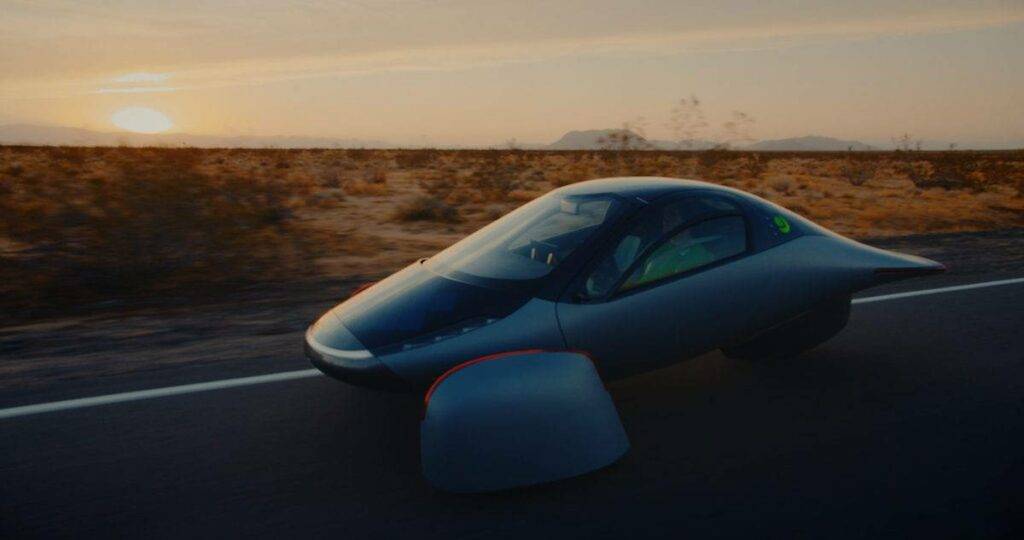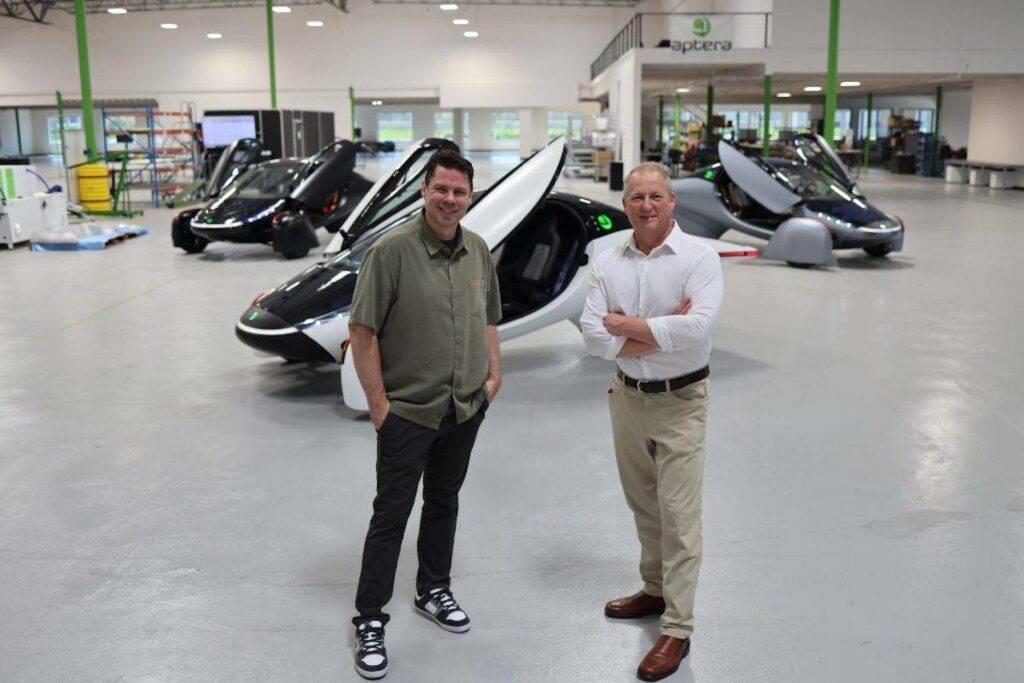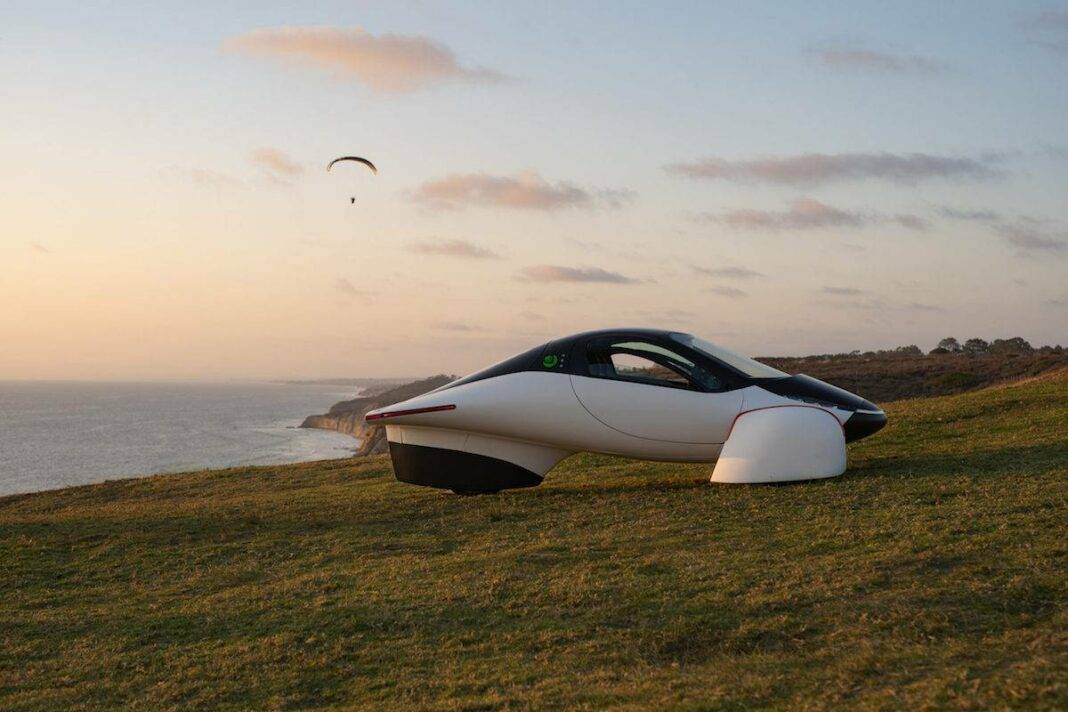An astonishing vehicle could be in your driveway next year, and your commute to work could be free.
One of the irritating things about being an environmentalist is that it’s generally not … cool. You know. Especially for transportation, it’s about using public transit or a bike or driving a Prius. Maybe Tesla was a little cool before Elon Musk morphed into a Bond villain, but aside from that, the cool factor in green transportation is low.
Enter the Aptera (Latin for wingless flight). This thing is cool as heck. Looks like nothing else on the road, like something you’d see rolling along in The Mandalorian (okay, vehicles in that show float, not roll, but you get it). “If you put Aptera in a lineup with every production car out there, you go … what’s that? There’s no way you’re not noticing the Aptera. It’s very, very different,” says co-CEO Chris Anthony. That’s by design.
The Technology of Less Is More
“We started with a math equation. How do you make the most aerodynamic vehicle possible? What does it look like to surround two people side-by-side for long-distance traveling? And we ended up with this thing that looks more like a fish than a regular car. And we kind of crossed our fingers and hoped that people would like it, and we put it out to the public and had 4,000 pre-orders in like the first week.”
In a recent news article, a reporter suggested that a two-seater electric car might be a hard sell, noting that the Smart car ceased US sales in 2019. Comparing the Smart car to the Aptera is like comparing a Cessna to an F-16 or a Ford Fiesta to a Ferrari, except in this case the Ferrari is cheaper and the fuel is free.
The Aptera is covered in solar panels, which provide up to 11,000 miles of free driving in sunny San Diego, or 8,000 in climes like Seattle or Ireland. But if you’re going to power a car with sun, it has to be incredibly efficient. So they designed the most aerodynamic vehicle possible (with three wheels), made it lightweight (about 2,000 pounds; a Tesla 3 weighs twice that), and engineered it to be remarkably tough and safe. (Basically, they stole a lot of tech from Formula 1 cars that crash at 200 mph and drivers walk away.)
The Aptera is covered in solar panels, which provide up to 11,000 miles of free driving in sunny San Diego, or 8,000 in climes like Seattle or Ireland.
The car’s design is thanks to a former Porsche designer, and the body panels are made in Italy by a company that produces bodies for other supercars. The motors are in the wheels, avoiding the efficiency losses of a conventional drivetrain. Its hatchback has 70 percent more cargo space than a Toyota Corolla. The base model will have a range of 250 miles, and you can order one with a 1,000-mile range.

When the sun isn’t filling your tank, so to speak, you can charge it with a regular extension cord (which you may never need to do); if you hook it up to a Tesla charger, you get 100 miles in 10 minutes. It goes zero to 60 in under four seconds, faster than a $400,000 Ferrari 812 GTS. It will cost as little as $25,900, and the top-of-the-line 1,000-mile version will run $45,000, about the price of an average new car. For comparison, the average EV is over $60,000. And the Aptera is far from average.
Since somewhere around 75 percent of working Americans commute alone in a car, and the average commute is well under the 40 miles a day Aptera says they can deliver for free, the Aptera could be a perfect commuter car. But Aptera is looking beyond that; with a 250-plus mile range and enough cargo space in the hatchback for a sleeping set-up they plan to offer for campers, Aptera emphasizes freedom. Freedom from range anxiety, from high EV prices, from high fuel prices.
Shut Up and Take My Money
At this point, if you’re ready to pony up for an Aptera, you’re not alone. But production is at least a year away. The Carlsbad assembly line that will pump out as many as 20,000 Apterae (that's the Latin plural) annually is designed (and computer animated), but is now just mapped in blue and green lines on the floor of their 80,000-square-foot facility. But fret not. You can reserve an Aptera, or if you’re really into the idea, you can invest in the company.
Crowdfunding as a true investment platform (unlike Kickstarter or GoFundMe) is a relatively new phenomenon, and of course a forward-thinking company like Aptera Motors has embraced it.
“I would have loved to invest in Tesla very early or Google or Apple very early on,” says Chris. “But [crowdfunding] didn’t exist when those companies were started up. So now that this exists, hopefully a lot of great technologies will use the crowd to launch their ideas.” Aptera has 16,000 individual investors. “Our crowdfunding continues to bring in bucks from individual people who are just like, ‘This is amazing, I want to support this in any way I can.’ Our average investor is $4,700, so people every day find our website, look at videos … ‘How can I become a part of this? I can invest? Okay, sweet.’ So, they reserve a vehicle. They get a free reservation if they invest more than $1,000.”
“We started with a math equation. How do you make the most aerodynamic vehicle possible? What does it look like to surround two people side-by-side for long-distance traveling? And we ended up with this thing that looks more like a fish than a regular car.”
— co-CEO Chris Anthony
Aptera also has a website that’s remarkably informative for potential investors; if you’ve got questions about anything from whether your favorite fast food beverage will fit through the oddly shaped window to “zonal architecture and low-voltage engineering,” there’s a video for it.
But Aptera Motors is not all crowdfunded. The business got a $22 million matching grant from the California Energy Commission “to keep jobs and innovation here in California, and we’re happy to do that.” They’re applying for federal loans. They’ve beat the bushes in the US, for institutional investors, and when that dried up, they went overseas and are having success.
But they’re still about $50 million from production, which Chris hopes to raise in the next six months to get Apterae on the road in 2024. “We’re not a software start-up. … You have to buy real equipment, you have to buy real tooling; shit’s not cheap.”
Cruising in an Aptera
On a sparkling spring day in Carlsbad, I got to ride in an Aptera. In two, actually. My driver, Jerry Xiong, a vehicle technician, first strapped me into “Beta,” a stripped-down testing version of the Aptera that has the most-advanced versions of the technology the Aptera will feature, and therefore rides and handles most like the production version will. It looked about half built, with open sides and absent body panels.
Jerry politely asked if I wanted to go fast. When I answered in the affirmative, he pinned me back into my seat with a lightning-quick acceleration.
As we rolled out in Beta, Jerry politely asked if I wanted to go fast. When I answered in the affirmative, he pinned me back into my seat with a lightning-quick acceleration, a trick he repeated whenever he had some open road on our quick loop around the block of office parks. The ride was smooth, the car handled the curves gracefully, and the overall effect was of a car on rails.
Next, I met “Alpha,” an earlier prototype that has the look of a completely finished vehicle, with all the creature comforts. It certainly felt futuristic, but also like a car, and the ride, while not quite as smooth as the more-advanced Beta, was just as fun. The Gamma version, which combines the tech of Beta and the finish of Alpha, is on a fundraising tour of Europe. Delta will be the production car.
The Road to Aptera
This Aptera is actually the second iteration of the company. Chris and his co-founder, Steve Fambro, started the company in 2005, but shuttered it in 2011; the technology and supply chains weren’t ready for the concept. So they re-started in 2019, when electric vehicle tech had caught up to their ideas. Then the pandemic brought some issues, including forcing the two to build the first Alpha prototype vehicle by themselves.

Aptera will only succeed with 1) enough funding to get production started, and 2) consumer acceptance. They’re confident they can get the funding, and they’re confident they’ll have the public.
“We have 42,000 pre-orders after about two years, so the public has said, ‘Yes, we like it.’ Our pace of pre-orders was more than Lucid, Fisker, Rivian, and you’ve heard those names, and they’re tremendously valuable companies, $20 billion companies. Our pre-orders say that people are more interested in efficiency and this angle on solar-powered transportation.”
And the environmental benefits are clear, even against other EVs. “We’re selling to kind of a unique crowd that maybe is more focused on … how their transportation impacts the planet. … Our vehicle uses a third of the metal, it uses a fifth of the battery pack, and obviously all the components are lightweight … so just the vehicle from inception uses so much less than another gasoline vehicle or certainly another electric vehicle. Less cobalt out of the ground, less aluminum and copper for the battery pack. Just everything is less. … I’m using a twentieth of the energy of a gasoline vehicle, and I’m using a fifth of the energy of an electric vehicle. For a lot of people that’s just smart engineering. I want to be driving the latest and greatest coolest tech.”
If this incredible wingless vehicle takes flight, green transport for a cooler planet will finally be cool.
Visit Aptera Motors to learn more.



A couple corrections: the entry level price is only $26,500, NOT $29,500. And the trunk space is 32 cubic feet, while a Toyota Corolla has merely 13 cubic feet, meaning there’s 2.5x or 150% more cargo space.
Thank you for covering this company. I’ve reading blue dot living previously and am now reminded that I need to continue!
Great article, glad to see the word getting out. This vehicle is cutting edge technology. I’ve had a ride in an alpha and the beta, I’m a reservation holder and an investor, number 49 on the leaderboard right now! If you study the details, you will be impressed.
I put down my very small deposit, but I am very exited for this vehicle. I hope they can make a lot of these.
If a picture speaks a thousand words… Imagine what the first two thousand Apterae will do!